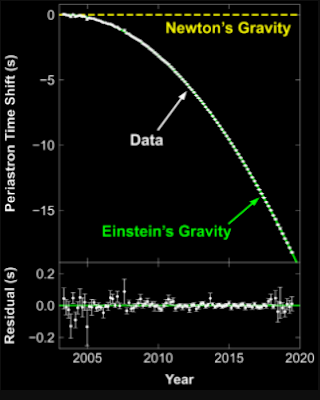Figure 1: The double pulsar is a pair of rotating neutron stars, both of which are pulsars. The light beams from each pulsar (yellow) are shown exiting through a donut-shaped magnetic field (blue). On Earth, we see these beams as flashes at regular intervals. As the two pulsars revolve around each other, gravitational waves are emitted (represented by “ripples” in the underlying spacetime fabric). By monitoring changes in the timing of the flashes, researchers have measured the amount of energy taken away by gravitational waves. This loss matches what Einstein’s general relativity predicts to a level of one part in 10,000.
Neutron stars are the densest celestial objects after black holes. But unlike black holes, some neutron stars emit beams of radiation out of their magnetic poles, producing a “lighthouse” effect as they rotate. By recording the flashes from these so-called pulsars, giant radio telescopes can infer the physical properties of neutron stars. For nearly two decades, Michael Kramer from the Max Planck Institute for Radio Astronomy, Germany, and his collaborators have monitored the double pulsar PSR J0737–3039A/B, a unique system composed of two pulsars in orbit around each other. The team has now released 16 years’ worth of their data. The gravity community has long awaited this update, as an earlier study—based on just 2.5 years of data—showed that the pulsar pair is an excellent testbed for strong-field gravity. The new extended dataset does not disappoint: It not only improves the precision of previous gravity tests by orders of magnitude, but it also enables a few new ones. Einstein’s general relativity passes all these challenges with flying colors.
Astrophysicists refer to neutron stars as superstars because of their superdense matter, superconducting/superfluid interiors, super-fast rotation, and super strong gravity and magnetism. The most relevant super property for gravity tests is that pulsars are superprecise clocks. Because of angular momentum conservation, neutron-star rotation is remarkably stable, which means the ticks of a pulsar clock have a long-term consistency comparable to that of the best atomic clocks on Earth. On top of that, neutron stars are almost as compact as black holes, meaning that their precise ticking occurs in highly curved spacetime. Certain alternative gravity theories predict that neutron-star clocks could display large deviations from general relativity predictions.
When a pulsar is located in a binary, the arrival times of pulses at radio telescopes are modified by the binary’s orbital motion in a characteristic way. Precise measurements of these arrival times over the course of years to decades allow tiny changes in the orbital motion to be detected. For example, observations of the Hulse-Taylor pulsar, the first known stellar binary containing a pulsar, revealed a shrinking in the orbital radius and an acceleration in the revolution rate—evidence that orbital energy was being lost to gravitational-wave radiation. In terms of studying gravitational effects, the double pulsar PSR J0737–3039A/B—detected in 2003—is, in many ways, superior to its binary rivals. First, it has the advantage that it is the only binary where both components are visible as pulsars (Fig. 1). Second, it is relatively nearby—at a distance of about 2000 light-years from Earth. Lastly, its orbital inclination with respect to us is near “edge-on” (about half a degree from 90°), which is fortuitous because the pulsar signals pass through the orbital plane where they can be imprinted by more of the binary’s curved spacetime. Thus, the double pulsar provides a unique window into the strong gravity regime.
The latest dataset reported by Kramer and co-workers was laboriously taken from 2003 to 2016 with six large radio telescopes located in Australia, the US, the Netherlands, France, Germany, and the UK. Combining these data was nontrivial, as the telescopes observe the double pulsar at different frequencies, on different days, and with different sensitivity. In addition, the high precision of the timing measurements required that the researchers take into account many astrophysical “contaminations.” For example, free electrons in the interstellar medium cause a time-varying, a dispersive effect that must be subtracted from the pulsar timing with the help of observations of the same pulsars made at different frequencies. The researchers also had to deal with the motion of the pulsars in the Milky Way with respect to our Solar System, as that changes the apparent ticking of pulsars.
The most significant result from the double-pulsar observations is the test of the quadrupole formula that describes the energy loss due to the emission of gravitational waves in Einstein’s general relativity. As gravitational waves take away orbital energy, the orbit size becomes smaller, and the revolution gets faster. This speedup is observable in a shift to shorter intervals between subsequent approaches to the periastron—the point when the orbiting pulsars are nearest to each other (Fig. 2). The latest observations from Kramer and colleagues deliver precision in the energy loss of 0.013% after correcting for effects from the pulsars’ motion relative to the Sun as well as for an effect from the pulsars’ spindown (rotational slowing caused by energy being lost to electromagnetic radiation). This precision in the gravitational-wave energy loss is much better than that obtained for the Hulse-Taylor pulsar (0.3%) as well as that measured by the LIGO and Virgo Collaboration for a binary neutron star merger (20%).
Figure 2: Cumulative shift of orbital periastron time for the double pulsar. The data are compared to two gravity theories: Einstein’s theory of relativity, which predicts gravitational-wave emission, and Newton’s theory, which does not. The observations by Kramer and co-workers show exceptional agreement with Einstein’s theory.
Besides the quadrupole-formula test, Kramer and co-workers significantly improved the precision of other gravity tests, such as the test of the Shapiro delay effect, whereby a curved spacetime makes radio signals travel for a longer time. In addition, the team performed relativity tests that have never been performed before in the double pulsar. They have, for example, measured a relativistic deformation of the orbit, a relativistic spin-orbit coupling between the pulsars’ rotations and their orbital motion, and a deflection of radio signals in the curved spacetime of the pulsars. All measurements are beautifully consistent with predictions from a single elegant and profound theory, Einstein’s general relativity.
These results provide empirical guidance for developing theories that go beyond Einstein’s. Some of these alternative gravity theories predict large deviations from general relativity in the strong-field regime. For example, Kramer and colleagues considered two classes of alternative gravity theories that augment Einstein’s general relativity with a massless scalar field. In general, these theories predict a bigger shift in the double pulsar’s periastron time shift than observed. The researchers are therefore able to rule out a large portion of parameter space for these alternative theories.
For now, Einstein’s theory remains unchallenged. However, future tests may eventually find a deviation. Testing gravity in the strong-field regime continues in ongoing experiments that measure gravitational waves and black hole shadows. And, of course, the double pulsar will continue to be monitored, so we can all wait for the next update on its timing evolution.
References
1. J. H. Taylor, “Binary pulsars and relativistic gravity,” Rev. Mod. Phys. 66, 711 (1994).
2. M. Kramer et al., “Strong-field gravity tests with the double pulsar,” Phys. Rev. X 11, 041050 (2021).
3. M. Kramer et al., “Tests of general relativity from timing the double pulsar,” Science 314, 97 (2006).




















